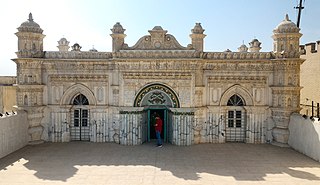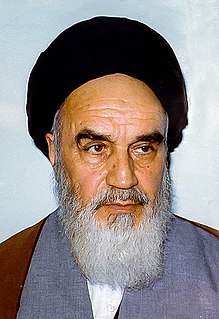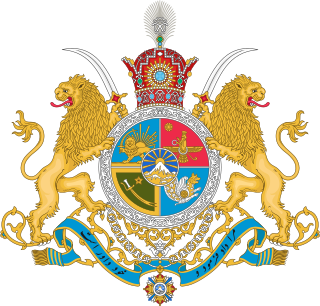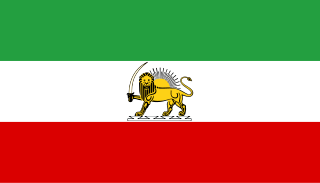Related Research Articles

Abadan is a city and capital of Abadan County, Khuzestan Province, which is located in the southwest of Iran. It lies on Abadan Island. The island is bounded in the west by the Arvand waterway and to the east by the Bahmanshir outlet of the Karun River, 53 kilometres (33 mi) from the Persian Gulf, near the Iran–Iraq border. Abadan is 140 km from the provincial capital city of Ahvaz.

Sayyid Ruhollah Musavi Khomeini, also known as Ayatollah Khomeini, was an Iranian political and religious leader who served as the 1st Supreme Leader of Iran from 1979 until his death in 1989. He was the founder of the Islamic Republic of Iran and the leader of the 1979 Iranian Revolution, which saw the overthrow of the last Shah of Iran, Mohammad Reza Pahlavi, and the end of the Persian monarchy. Following the revolution, Khomeini became the country's first supreme leader, a position created in the constitution of the Islamic Republic as the highest-ranking political and religious authority of the nation, which he held until his death. Most of his period in power was taken up by the Iran–Iraq War of 1980–1988. He was succeeded by Ali Khamenei on 4 June 1989.

SAVAK was the secret police, domestic security and intelligence service in Iran during the reign of the Pahlavi dynasty. It was established by Mohammad Reza Shah with the help of the U.S. Central Intelligence Agency (CIA) and Mossad. SAVAK operated from 1957 until the Iranian Revolution of 1979, when the prime minister Shapour Bakhtiar ordered its dissolution during the outbreak of Iranian Revolution.

Mohammad Mosaddegh was an Iranian politician who served as the 35th Prime Minister of Iran, holding office from 1951 until 1953, when his government was overthrown in the 1953 Iranian coup d'état orchestrated by the United Kingdom's MI6 and the American CIA, led by Kermit Roosevelt Jr.

Reza Shah Pahlavi was an Iranian military officer, politician, and first Shah of the House of Pahlavi of the Imperial State of Iran and father of the last Shah of Iran. He reigned from 15 December 1925 until he was forced to abdicate by the Anglo-Soviet invasion of Iran on 16 September 1941. Reza Shah introduced many social, economic, and political reforms during his reign, ultimately laying the foundation of the modern Iranian state. Therefore, he is regarded as the founder of modern Iran.

The Pahlavi dynasty is the last Iranian royal dynasty, ruling for almost 54 years between 1925 and 1979. The dynasty was founded by a non-aristocratic Mazanderani soldier in modern times, who took on the name of the Pahlavi language spoken in the pre-Islamic Sasanian Empire in order to strengthen his nationalist credentials.

The Iranian Revolution, also known as the Islamic Revolution was a series of events that culminated in the overthrow of the Pahlavi dynasty under Shah Mohammad Reza Pahlavi, and the replacement of his government with an Islamic republic under the rule of Ayatollah Ruhollah Khomeini, a leader of one of the factions in the revolt. The revolution was supported by various leftist and Islamist organizations.

The 1953 Iranian coup d'état, known in Iran as the 28 Mordad coup d'état, was the overthrow of the democratically elected Prime Minister Mohammad Mosaddegh in favour of strengthening the monarchical rule of the Shah, Mohammad Reza Pahlavi on 19 August 1953. It was orchestrated by the United States and the United Kingdom. The clergy also played a considerable role.

The Anglo-Persian Oil Company (APOC) was a British company founded in 1909 following the discovery of a large oil field in Masjed Soleiman, Iran. The British government purchased 51% of the company in 1914, gaining a controlling number of shares, effectively nationalizing the company. It was the first company to extract petroleum from Iran. In 1935 APOC was renamed the "Anglo-Iranian Oil Company" (AIOC) when Reza Shah Pahlavi formally asked foreign countries to refer to Persia by its endonym Iran.
The Tudeh Party of Iran is an Iranian communist party. Formed in 1941, with Soleiman Mirza Eskandari as its head, it had considerable influence in its early years and played an important role during Mohammad Mosaddegh's campaign to nationalize the Anglo-Persian Oil Company and his term as prime minister. The crackdown that followed the 1953 coup against Mosaddegh is said to have "destroyed" the party, although a remnant persisted. The party still exists, but has remained much weaker as a result of its banning in Iran and mass arrests by the Islamic Republic in 1982, as well as the executions of political prisoners in 1988.

The National Front of Iran is an opposition political organization in Iran, founded by Mohammad Mosaddegh in 1949. It is the oldest and arguably the largest pro-democracy group operating inside Iran despite having never been able to recover the prominence it had in the early 1950s.

The Pan-Iranist Party is a small opposition political party in Iran that advocates pan-Iranism. The party is not registered and is technically banned, however it continues to operate inside Iran.

The Party of Resurrection of the Iranian Nation or simply Rastakhiz Party was Iran's single legal political party from 2 March 1975 until 1 November 1978, founded by the Shah Mohammad Reza Pahlavi.

Mirza Abol-Qasem Qa'em-Maqam Farahani, also known as Qa'em-Maqam II, was an Iranian official and prose writer, who played a central role in Iranian politics in first half of the 19th-century, as well as in Persian literature.

The demonstrations of June 5 and 6, also called the events of June 1963 or the 15 Khordad uprising, were protests in Iran against the arrest of Ayatollah Ruhollah Khomeini after his denouncement of Iranian Shah Mohammad Reza Pahlavi and Israel. The Shah's regime was taken by surprise by the massive public demonstrations of support, and although these were crushed within days by the police and military, the events established the importance and power of (Shia) religious opposition to the Shah, and Khomeini as a major political and religious leader. Fifteen years later, Khomeini was to lead the Iranian Revolution which overthrew the Shah and his Pahlavi dynasty and established the Islamic Republic of Iran.
The consolidation of the Iranian Revolution refers to a turbulent process of Islamic Republic stabilization, following the completion of the revolution. After the Shah of Iran and his regime were overthrown by revolutionaries in February 1979, Iran was in a "revolutionary crisis mode" from this time until 1982 or 1983. Its economy and the apparatus of government collapsed. Military and security forces were in disarray.

The Iranian Revolution was the Shia Islamic revolution that replaced the secular monarchy of Shah Mohammad Reza Pahlavi with a theocracy led by Ayatollah Ruhollah Khomeini.

The Imperial State of Iran was the official name of Iran under rule of the Pahlavi dynasty.

Qajar Iran, also referred to as Qajar Persia, the Qajar Empire, officially the Sublime State of Iran and also known then as the Guarded Domains of Iran, was an Iranian state ruled by the Qajar dynasty, which was of Turkic origin, specifically from the Qajar tribe, from 1789 to 1925. The Qajar family took full control of Iran in 1794, deposing Lotf 'Ali Khan, the last Shah of the Zand dynasty, and re-asserted Iranian sovereignty over large parts of the Caucasus. In 1796, Mohammad Khan Qajar seized Mashhad with ease, putting an end to the Afsharid dynasty. He was formally crowned as Shah after his punitive campaign against Iran's Georgian subjects. In the Caucasus, the Qajar dynasty permanently lost many of Iran's integral areas to the Russian Empire over the course of the 19th century, comprising modern-day Georgia, Dagestan, Azerbaijan and Armenia. Despite its territorial losses, Qajar Iran maintained its political independence and reinvented the Iranian notion of kingship.

Socialism inIran or Iranian socialism is a political ideology that traces its beginnings to the 20th century and encompasses various political parties in the country. Iran experienced a short Third World Socialism period at the zenith of the Tudeh Party after the abdication of Reza Shah and his replacement by his son, Mohammad Reza Pahlavi. After failing to reach power, this form of third world socialism was replaced by Mosaddegh's populist, non-aligned Iranian nationalism of the National Front party as the main anti-monarchy force in Iran, reaching power (1949–1953), and it remained with that strength even in opposition until the rise of Islamism and the Iranian Revolution. The Tudehs have moved towards basic socialist communism since then.
References
- ↑ Margaret Irene Laing (February 1977). The Shah. Sidgwick & Jackson. p. 209.
- 1 2 Dishon (1 October 1973). Middle East Record 1968. John Wiley & Sons. pp. 489–. ISBN 978-0-470-21611-8.
- ↑ Year Book Covering the Year ... Crowell-Collier Educational Corporation. 1968. p. 307.
- ↑ Venkateswarier Subramaniam (1990). Public Administration in the Third World: An International Handbook. Greenwood Publishing Group. pp. 171–. ISBN 978-0-313-24730-9.